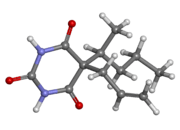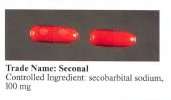Secobarbital
 | |
 | |
| Clinical data | |
|---|---|
| Trade names | Seconal |
| AHFS/Drugs.com | Consumer Drug Information |
| MedlinePlus | a682386 |
| Pregnancy category |
|
| Routes of administration | Oral |
| ATC code | N05CA06 (WHO) QN51AA02 (WHO) |
| Legal status | |
| Legal status |
|
| Pharmacokinetic data | |
| Bioavailability | ? |
| Protein binding | 45-60%[1] |
| Metabolism | Hepatic |
| Biological half-life | 15-40 hours[1] |
| Excretion | Renal |
| Identifiers | |
| |
| CAS Number |
76-73-3 |
| PubChem (CID) | 5193 |
| IUPHAR/BPS | 7615 |
| DrugBank |
DB00418 |
| ChemSpider |
5005 |
| UNII |
1P7H87IN75 |
| KEGG |
D00430 |
| ChEBI |
CHEBI:9073 |
| ChEMBL |
CHEMBL447 |
| ECHA InfoCard | 100.000.894 |
| Chemical and physical data | |
| Formula | C12H18N2O3 |
| Molar mass | 238.283 |
| 3D model (Jmol) | Interactive image |
| |
| |
| (verify) | |
Secobarbital sodium (marketed by Eli Lilly and Company, and subsequently by other companies as described below, under the brand name Seconal) is a barbiturate derivative drug that was patented in 1934 in the US.[2] It possesses anaesthetic, anticonvulsant, anxiolytic, sedative, and hypnotic properties. In the United Kingdom, it was known as quinalbarbitone. It is the most frequently used drug in physician-assisted suicide within the United States.[3]
Indications
Secobarbital is indicated for:
- Treatment of epilepsy
- Temporary treatment of insomnia
- Use as a preoperative medication to produce anaesthesia and anxiolysis in short surgical, diagnostic, or therapeutic procedures which are minimally painful.
Availability

Ranbaxy Pharmaceuticals, an India-based company now predominantly owned by the Japanese company Daiichi Sankyo, obtained the rights to market and to use the trade name "Seconal" from Eli Lilly in 1998, and did so until September 18, 2008. The actual manufacturer of Seconal subsequent to the time Eli Lilly manufactured the drug was Ohm Pharmaceuticals, a wholly owned subsidiary of Ranbaxy. The rights to market Seconal were then sold to Marathon Pharmaceuticals,[4] which became the marketer and trade-name holder. In February 2015, Marathon sold the rights to Valeant Pharmaceuticals.[5] However Seconal is still manufactured by Ohm.[6] In the United States, Seconal is available only in 100 mg capsules, as a sodium salt. The salt is a white hygroscopic powder that is soluble in water and ethanol.
After the rights to Seconal were sold to Valeant Pharmaceuticals in 2015, Valeant immediately doubled the price in the United States from $1,500 per 100 capsules to $3,000. While generic versions of the drug used to exist after the Seconal patent expired in the early 1990s, there are currently no generics available on the US market, making Valeant the sole vendor of the drug in the US. [3]
Secobarbital sodium
The sodium salt of secobarbital is classified separately from the free acid, as follows:
- CAS number: 309-43-3
- Chemical formula: C12H18N2NaO3
- Molecular weight: 260.265
Side effects
Possible side effects of secobarbital include:
- Somnolence
- Impaired motor functions
- Impaired coordination
- Impaired balance
- Dizziness
- Anxiety
- Confusion
- Agitation, irritability, or excitability
- Headache
- Nausea
- Vomiting
- Nightmares
- Increased sensitivity to pain
- Allergic reactions
Withdrawal
Secobarbital may produce psychological addiction and produces physical dependence if used for an extended period of time. Withdrawal symptoms may occur if long-term use is abruptly ended, and can include:
- Anxiety
- Insomnia
- Lack of appetite
- Seizures
- Tremors
- Possible death as a result of withdrawal
Recreational use
Secobarbital was widely misused in the 1960s and 1970s, and accidental overdose was associated with the drug. It was linked with the death of Judy Garland, where the postmortem found that her blood contained the equivalent of ten 1.5-grain (97 mg) Seconal capsules. Additionally the drug played a key role in the suicide of Charles Boyer in 1978. Consequently, the prescription of Seconal decreased greatly, beginning in the early 1980s by which time benzodiazepines had become increasingly common. Secobarbital has acquired many nicknames, the most common being "reds", "red devils", or "red dillies" (because of the color of the capsules). Other common nicknames are "seccies", "Cardinals", "ruby slippers" and, according to the Wegman's School of Pharmacy curriculum, "red hearts". A less common nickname is "dolls"; this was partly responsible for the title of Jacqueline Susann's novel Valley of the Dolls, whose main characters use secobarbital and other such drugs.
Another celebrity death attributed to secobarbital was that of Anissa Jones (a child star who played Buffy on Family Affair) on August 28, 1976. It was detected in her system, along with cocaine, PCP and methaqualone, but it was the only pharmaceutical in her toxicology report which led to homicide charges against a vendor, that being Dr. Don Carlos Moshos, who dispensed it without a proper cause or examination (as well as for Jones' recreational use), according to a postmortem criminal investigation.
Actress Lupe Velez's death was also reportedly caused by an overdose of the drug.
Secobarbital was implicated in the death of Dinah Washington. Early on the morning of December 14, 1963 Washington's seventh husband, football great Dick "Night Train" Lane, went to sleep with his wife and awoke later to find her slumped over and not responsive. Doctor B. C. Ross came to the scene and pronounced her dead. An autopsy later showed a lethal combination of secobarbital and amobarbital, which contributed to her death at the age of 39. She is buried in the Burr Oak Cemetery in Alsip, Illinois.
Use in animal and human euthanasia
In the Netherlands, individuals have two options for euthanasia. They can orally consume 100 ml of concentrated syrup containing either 15 grams of pentobarbital or 15 grams of secobarbital; or they can choose to have 2 grams of thiopental or 1 gram of propofol administered intravenously by a doctor, followed by a muscle relaxant.[7] In recent years only 15% of those who died by euthanasia opted for orally consuming the lethal drug(s), the rest choosing to have the drugs administered intravenously by a doctor instead.[8]
In the US, secobarbital and pentobarbital are the most common drugs prescribed under physician aid in dying laws in Oregon since 1998, Washington since 2008, Vermont since 2013, and New Mexico since 2014.[9][10][11] Ranbaxy Laboratories Limited previously experienced various issues in their attempts to produce 100 mg secobarbital capsules.
It is a component in the veterinary drug Somulose, used for euthanasia of horses and cattle.
The LD50 of secobarbital has been reported to be between 125 mg/kg(rat, oral) and 267 mg/kg(mouse, oral).[12]
See also
References
- 1 2 Lexi-Comp. "Secobarbital".
- ↑ US patent 1954429, Shonle, H. A., "Propyl-Methyl Carbinyl Allyl Barbituric Acid and its Salts", issued 1934-04-10, assigned to Eli Lilly
- 1 2 Dembosky, April. "Drug Company Jacks Up Cost Of Aid-In-Dying Medication". NPR.org. Retrieved 2016-03-24.
- ↑ "» Seconal Sodium®". Marathonpharma.com. 2013-07-31. Retrieved 2014-03-05.
- ↑ "Marathon Pharma to Focusing Exclusively on Rare Disease". Marathon Pharmaceuticals, LLC. Retrieved 2016-03-24.
- ↑ "Seconal Sodium - FDA prescribing information, side effects and uses". www.drugs.com. Retrieved 2016-03-24.
- ↑ unknown; et al. (July 29, 2010). "Hulp bij zelfdoding(Dutch)". Oncoline.
- ↑ Heleen Croonen; et al. (April 1, 2010). "Euthanasiedrank verliest terrein(Dutch)". Medisch contact.
- ↑ Elizabeth Trice Loggers, M.D., Ph.D; et al. (April 11, 2013). "Implementing a Death with Dignity Program at a Comprehensive Cancer Center". New England Journal of Medicine.
- ↑ "Oregon's Death with Dignity Act 2013 Report" (PDF). Oregon Health Authority. January 28, 2014.
- ↑ Katrina Hedberg, M.D., M.P.H.; et al. (March 6, 2003). "Five Years of Legal Physician-Assisted Suicide in Oregon". New England Journal of Medicine.
- ↑ NIH. "Secobarbital - Human Health Effects".
External links
- Marathon Pharmaceuticals - Seconal Full prescribing information for the United States.
- Drugs.com - Secobarbital
- RxList.com - Secobarbital Consumer information.